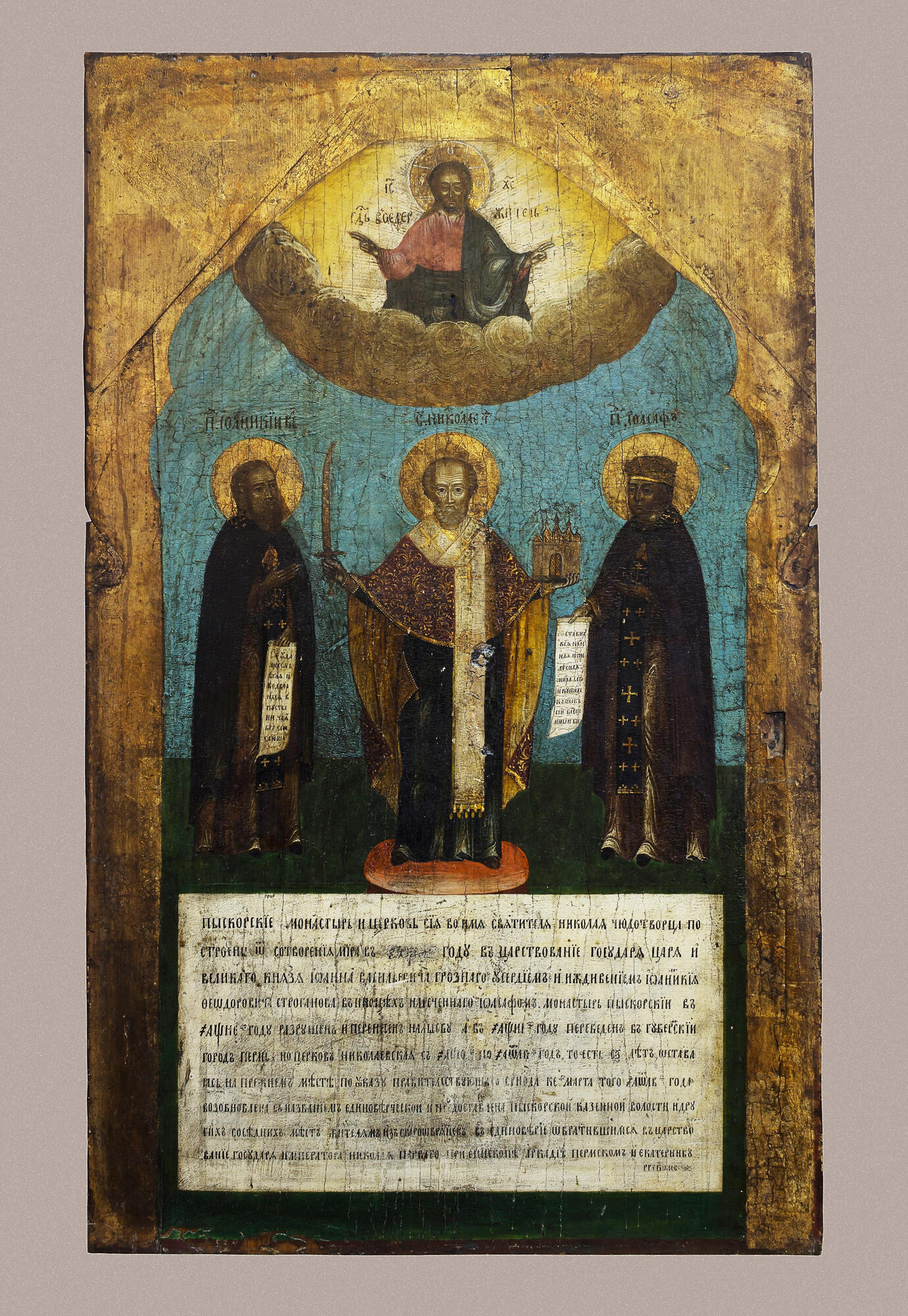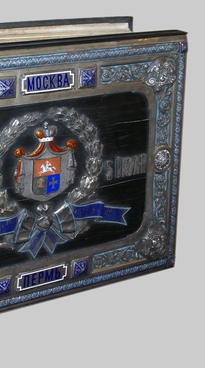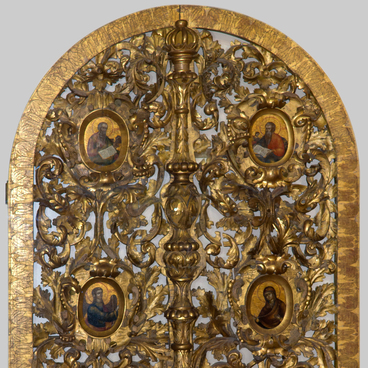The icon of St Nicholas of Mozhaisk with the Reverends Ioannikios the Great and Joasaph and the Chronicles of the PYskor Monastery was submitted to the museum by the NikOlskaya church of PYskor village.
Nikolas of Mozhaisk is a carved wooden image of St. Nicholas the Wonderworker, which once stood at the gates of Mozhaisk town where it got its name. Saint Nicholas is presented as full length with his arms spread apart. He holds a sword in his right hand and a walled town or temple in his left hand. This image has become one of the most widespread and beloved in Russia.
The icon depicts Ioannikios the Great - patron saint of AnIka Stroganov to the left of Nikolai of Mozhaisk. Anikey Stroganov (1488-1569 / 70) was the creator of the salt industry in SolvychegOdsk and Perm the Great, a colonizer of the Kama lands, statesman and the largest Russian businessman of his time.
Throughout his life, Stroganov was very religious. He built several churches at his own account, including a temple in SolvychegOdsk, and made donations to monasteries. At the end of the 1550s, Stroganov and his sons founded a monastery on the right bank of the Kama River, at the mouth of the Lower PYskorka River. In old age, he retired from social life and took monastic vows at the PYskor monastery, being named as Joasaph.
There is the second namesake to the right of Nicholas the Wonderworker on the icon; that is Joasaph, the patronal saint of AnIka Stroganov, and an Indian prince of the holy Orthodox Church.
The NikOlskaya Church where the icon was kept is located in PYskor village, UsOlye District, Perm Territory. It was built in 1695 at the expense of the salt industrialist Grigory Shustov as a part of the PYskor Transfiguration Monastery.
In 1755 the Monastery of the Transfiguration of the Saviour was transferred to another place - to the LYsva River. The old monastery buildings were dismantled, and the St. Nicholas Church remained in the same place and served as a hospital, and later a cemetery church. During its existence, the monastery changed three locations, each time being located upstream of the Kama.
The five-tiered iconostasis created by the brethren for a new building of the Transfiguration Church erected near the LYsva River between 1758 and 1762 has also survived as the heritage of the PYskor Monastery. Then, the iconostasis was moved to the Perm Cathedral.
Nikolas of Mozhaisk is a carved wooden image of St. Nicholas the Wonderworker, which once stood at the gates of Mozhaisk town where it got its name. Saint Nicholas is presented as full length with his arms spread apart. He holds a sword in his right hand and a walled town or temple in his left hand. This image has become one of the most widespread and beloved in Russia.
The icon depicts Ioannikios the Great - patron saint of AnIka Stroganov to the left of Nikolai of Mozhaisk. Anikey Stroganov (1488-1569 / 70) was the creator of the salt industry in SolvychegOdsk and Perm the Great, a colonizer of the Kama lands, statesman and the largest Russian businessman of his time.
Throughout his life, Stroganov was very religious. He built several churches at his own account, including a temple in SolvychegOdsk, and made donations to monasteries. At the end of the 1550s, Stroganov and his sons founded a monastery on the right bank of the Kama River, at the mouth of the Lower PYskorka River. In old age, he retired from social life and took monastic vows at the PYskor monastery, being named as Joasaph.
There is the second namesake to the right of Nicholas the Wonderworker on the icon; that is Joasaph, the patronal saint of AnIka Stroganov, and an Indian prince of the holy Orthodox Church.
The NikOlskaya Church where the icon was kept is located in PYskor village, UsOlye District, Perm Territory. It was built in 1695 at the expense of the salt industrialist Grigory Shustov as a part of the PYskor Transfiguration Monastery.
In 1755 the Monastery of the Transfiguration of the Saviour was transferred to another place - to the LYsva River. The old monastery buildings were dismantled, and the St. Nicholas Church remained in the same place and served as a hospital, and later a cemetery church. During its existence, the monastery changed three locations, each time being located upstream of the Kama.
The five-tiered iconostasis created by the brethren for a new building of the Transfiguration Church erected near the LYsva River between 1758 and 1762 has also survived as the heritage of the PYskor Monastery. Then, the iconostasis was moved to the Perm Cathedral.



